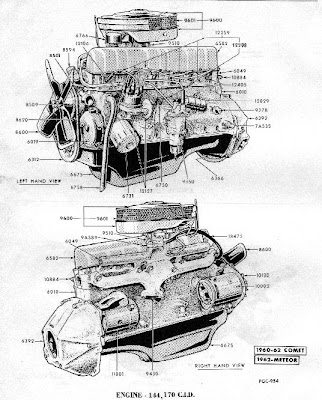Sunday, November 4, 2007
1960 Comet Options and Accessories
Deluxe Trim Package at $58.00
Heater / Defroster at $74.30
Back up lights at $10.70
Padded Dash Panel and Sun visors at $22.40
Two Tone Paint Scheme at $19.40
Push Button “AM” Radio at $58.80
Tinted Windshield at $13.70
Two Speed Windshield Wiper at $9.65
Electric Tailgate Window (Station Wagons) at $33.00
1960 Comet Technical Specifications
The 144 in line six also put out 90 hp. at 4200rpm, and was equipped with a single barrel Holly carburetor. The engine had four main bearings and put out extremely good torque at 138 ft. lbs. at 2000 rpm. This combination could push the Comet to a top speed of approximately 80 mph.

144 cubic inch engine spec sheet (Private Collection of D. Hendricks)
Also this little engine had great accessibility to all of the external parts with the oil filter, distributor, spark plugs, coil, and fuel pump located on the left side of the engine block.
The 1960 Comet passenger cars had a wheelbase of 114 inches making them longer than most compact cars of that year and with an over length of 194.8 inches the Comet was actually 14 inches longer than the Ford Falcon. This additional length gave the Comet a much smoother and superior ride than the Falcon or other similar cars yet at the same time it was much smaller than the full size cars and the smaller size gave the Comet much better maneuverability.
The interior dimensions of the Comet and the Ford Falcon were practically identical, the cloth covered trunk area of the Comet was dramatically larger with 28 cubic feet of available space.
The Comet front seat had more foam padding for added comfort, and adjusted a full four inches from front to back.
Original 1960 Factory Service Manual (Private Collection of D. Hendricks)
The instrument panel was similar to the Ford Falcon with different instruments being used. The speedometer was centrally located and had large easily read numbers. The only other gauges were the fuel gauge, and the temperature gauge. The battery charge gauge and the oil pressure gauge were indicated with red lights. Optional padding was also available on the dash panel for a small additional charge.
The Comet weighed about 100 lbs. more than the Ford Falcon, and with the additional weight, and the little 144 cubic inch as the only available engine, the Comet was a bit sluggish in take off and overall speed. When the 144 was coupled to the optional Mercomatic Transmission ($172.00), the Comet could go from zero to sixty in 25.1 seconds. The Mercomatic was a two speed, torque converter type transmission with the housing constructed of aluminum giving it a lighter weight.
When equipped with the factory three-speed manual transmission, the Comet would go from zero to sixty in a little better time of 17.7 seconds. The factory supplied three-speed transmission was a synchromesh in second (1.75 ratio) and high (3.29 ratio). The shift lever was mounted on the steering column within easy reach.
These rear axles consisted of the factory equipment 3.10 to 1 axle, the 3.50 to 1 axle, the 3.56 to 1 axle, and the 3.89 to 1 axle.
This years Comet came factory equipped with 6.00 x 13 wheels and tires. The rear suspension was of the standard Hotchkiss type with five, fifty-two inch long leaf springs. Full-length butyl liners separated each spring. Larger eye spring bushings support the springs and minimized road noise.
The front suspension had coil springs that were mounted in a shock tower above the A-arm assembly, while the lower arms were stamped channels, thus giving the wheels a controlled fore and aft motion. Tube type shocks were mounted inside the coils springs, while the anti-sway bars also added stability.
The braking system is of the duo-server type with over 226 square inches of total drum area giving the Comet excellent stopping ability.
The steering starts with a seventeen-inch diameter steering wheel connecting through a recirculating ball steering gear to a parallelogram-type linkage. Overall steering ratio was 27 to 1 and it would take full 4.6 turns to go from wheel lock to wheel lock position.
1960 Comet Production
In this first year of production, the 1960 Comet was very successful with a total production number of 116,331 units. The public found the smaller size and economical engine combined with the luxurious interior appointments a much more appealing alternative to the full size cars of this time.
1960 Advertisment Artwork (Private Collection of D. Hendricks)
The 1960 Comet had only one model but had four body styles from which to choose. These body styles consisted of the following -
The first was a 4-door, six-passenger family sedan, which had a total production of 47,416 units. This sedan had a factory price of $2053.00 and weighed 2433 lbs.
The second body style was a 2-door, six-passenger sedan with a total production of 45,374 units. This sedan was factory priced at $1998.00 and weighed 2399 lbs.
The third body style was the 4-door, six-passenger station wagon with a total production of 18, 426 units. This wagon was factory priced at $2365.00 and weighed 2581 lbs.
The fourth and final body style of the 1960 Comet was the 2-door, six-passenger station wagon with a total production of 5115 units. This wagon was factory priced at $2310.00 and weighed 2548 lbs.

